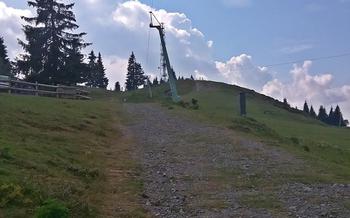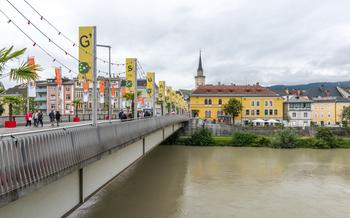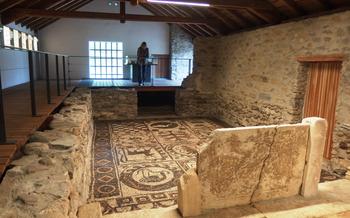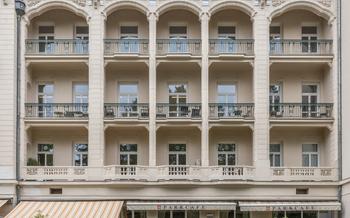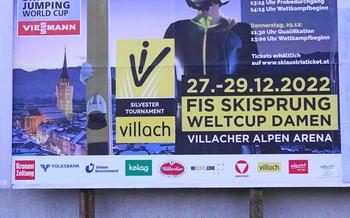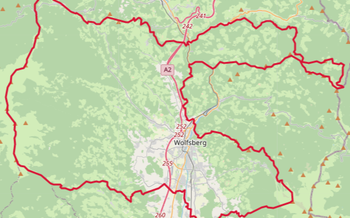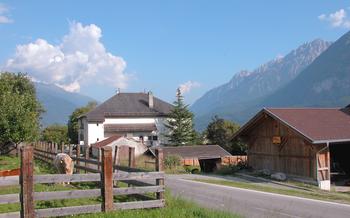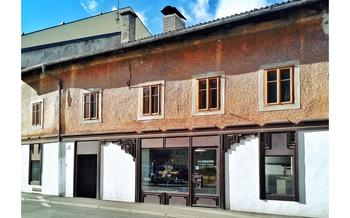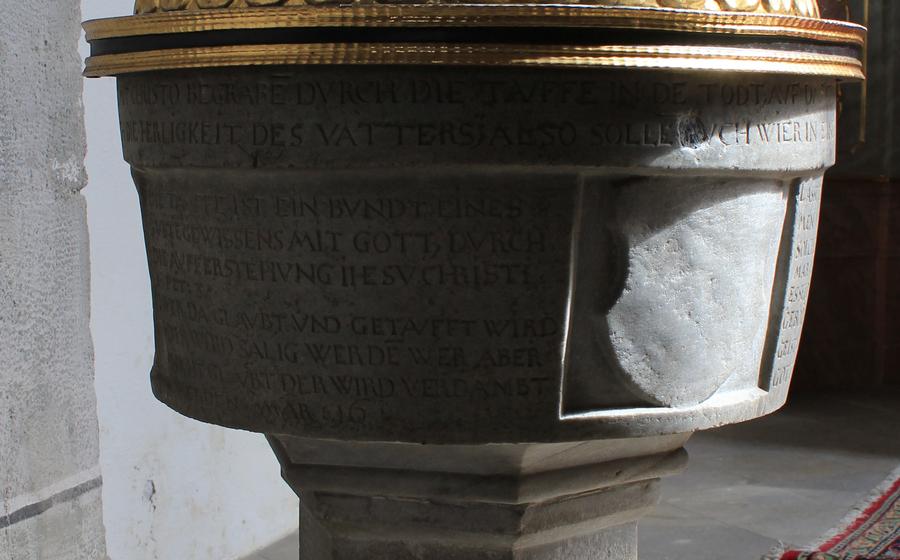
Gailtal Bauer Farmhouse Museum
- The Farmhouses: A Window into the Past
- Agriculture and Animal Husbandry
- Crafts and Skills of the Past
- The Role of Women in Rural Life
- Family Life and Traditions
- Educational Programs and Workshops
- Special Events and Demonstrations
- Surrounding Attractions and Activities
- Food and Accommodation
- Photography and Social Media
- Accessibility and Facilities
- Sustainable Tourism Practices
- Research and Documentation
- Insider Tip: Hidden Gem
The Farmhouses: A Window into the Past
The Gailtal Bauer Farmhouse Museum showcases a collection of well-preserved farmhouses that offer a glimpse into the architectural styles, building techniques, and interior design of the region. These farmhouses, ranging from the 16th to the 19th century, represent the diversity of rural architecture in the Gailtal Valley.
The farmhouses are constructed using traditional local materials, such as wood, stone, and clay. The construction techniques employed reflect the ingenuity and craftsmanship of the builders, who used mortise and tenon joints, wooden pegs, and thatched roofs to create sturdy and weather-resistant structures.
Inside the farmhouses, visitors can explore the living quarters, which feature a central hearth, wooden furnishings, and simple decorations. The layout of the rooms reflects the daily life and work of the farmers, with separate spaces for cooking, sleeping, and storage. Visitors can also see the farmhouses' outbuildings, such as barns, stables, and workshops, which provide insights into the agricultural practices and animal husbandry of the past.
Agriculture and Animal Husbandry
Traditional Farming Methods
Farming in Gailtal Valley has been shaped by the region's unique geography and climate. The Gail River, which flows through the valley, provides water for irrigation and transportation. The valley's slopes are terraced to prevent erosion and maximize the use of land. Farmers in Gailtal have traditionally used a variety of methods to cultivate their land, including crop rotation, composting, and manure spreading. They have also developed ingenious ways to protect their crops from pests and diseases.
Crops and Livestock Raised
The farmers of Gailtal Valley have traditionally grown a variety of crops, including wheat, rye, barley, oats, potatoes, and turnips. They have also raised livestock, such as cattle, pigs, sheep, and goats. These animals provided the farmers with milk, meat, and wool. The farmers also kept bees to produce honey.
Tools and Equipment Used
The farmers of Gailtal Valley have used a variety of tools and equipment to cultivate their land and care for their animals. These tools include plows, harrows, sickles, scythes, and flails. They have also used carts and wagons to transport their crops and livestock.
Challenges Faced by Farmers
The farmers of Gailtal Valley have faced a number of challenges over the years. These challenges include droughts, floods, hailstorms, and pests. The farmers have also had to deal with the changing economic conditions that have affected the region. Despite these challenges, the farmers of Gailtal Valley have managed to maintain a strong agricultural tradition.
Crafts and Skills of the Past
The Gailtal Bauer Farmhouse Museum showcases the rich array of crafts and skills that were essential to rural life in the region. Woodworking and carpentry were fundamental, with farmers crafting everything from furniture to tools and agricultural implements using locally sourced wood. Blacksmithing and metalworking were also crucial, as farmers relied on metal tools and equipment for their work.
The museum's exhibits highlight the intricate skills of spinning, weaving, and textile crafts. Women played a significant role in these crafts, transforming wool, flax, and hemp into yarn and fabrics for clothing, bedding, and other household items. Basketry, using natural materials like willow and straw, was another essential skill, producing baskets, mats, and other containers for various purposes.
These traditional crafts not only provided essential goods for rural households but also served as a source of income. Farmers and their families often sold their handcrafted items at local markets, supplementing their income and contributing to the local economy. Visitors to the museum can admire the exquisite craftsmanship of these traditional products and gain a deeper appreciation for the skills and ingenuity of past generations.
The Role of Women in Rural Life
Women in rural Austria played a crucial role in the functioning of the household and farm. Their duties extended beyond domestic responsibilities, as they actively contributed to the farm's economy and the well-being of the family.
Women were responsible for cooking, cleaning, gardening, and raising poultry and livestock. They played a vital role in food preservation, ensuring that the family had enough provisions during the winter months. Additionally, women were often skilled in traditional crafts such as spinning, weaving, and embroidery, which provided additional income for the family.
Despite their essential contributions, women's education and opportunities were limited. They were primarily expected to fulfill their domestic and agricultural roles, with few chances for formal education or career advancement. However, in recent decades, there has been a gradual shift in attitudes and opportunities for women in rural areas.
Today, women in rural Austria have more access to education and employment opportunities, leading to changing roles and responsibilities within the family and community. While traditional gender roles still exist, there is a growing recognition of the importance of gender equality and the contributions of women to rural life.
Family Life and Traditions
Family bonds and traditional values underpinned the rural way of life. The family unit, often comprising multiple generations, worked together to run the farm and maintain the household. Each member had specific roles and responsibilities within the family structure. Men were responsible for outdoor tasks such as farming and forestry, while women handled domestic chores like cooking, cleaning, and childcare. Children were expected to contribute to the family's well-being by helping with chores and learning traditional skills from their parents and grandparents. This close-knit family structure fostered a sense of community, cooperation, and interdependence among its members.
Celebrations and festivals punctuated the rural calendar, providing opportunities for the community to come together and celebrate life's milestones. Religious holidays, such as Christmas and Easter, were marked with special traditions and feasts. The changing seasons were also celebrated with festivals, marking the start of planting, harvesting, or the changing of seasons. These celebrations not only provided moments of joy and merriment but also reinforced the bonds of community and the continuity of traditions from one generation to the next.
Educational Programs and Workshops
The Gailtal Bauer Farmhouse Museum offers a range of educational programs and workshops designed to engage visitors of all ages and provide hands-on experiences. Interactive activities allow participants to learn about traditional crafts and skills, farming practices, and rural traditions.
Workshops on woodworking, blacksmithing, spinning, weaving, and other crafts provide an opportunity to try these skills under the guidance of experienced instructors. Cooking classes introduce participants to traditional Austrian cuisine, using fresh, locally sourced ingredients. Farming workshops teach visitors about traditional farming methods, crop cultivation, and animal husbandry.
These educational programs not only provide a fun and engaging way to learn about rural life but also promote cultural heritage and sustainability. Visitors can take home new skills and knowledge, appreciate the value of traditional practices, and contribute to preserving cultural diversity.
Special Events and Demonstrations
The Gailtal Bauer Farmhouse Museum brings the past to life through regular events and demonstrations that showcase traditional crafts and skills. Visitors have the opportunity to interact with museum staff and experts, learning about the techniques and tools used by farmers and artisans of the past. These events provide a glimpse into the rich cultural heritage of the Gailtal Valley and allow visitors to experience firsthand the skills that shaped the region's history.
One of the most popular events is the annual "Crafts Day," which takes place in the summer months. During this event, visitors can watch demonstrations of woodworking, blacksmithing, spinning, weaving, and other traditional crafts. Skilled artisans share their knowledge and techniques, allowing visitors to appreciate the artistry and craftsmanship that went into everyday objects in the past.
Another highlight is the "Harvest Festival," which celebrates the end of the growing season and the abundance of the land. Visitors can experience traditional harvesting methods, learn about the importance of agriculture in rural life, and sample local produce and delicacies. These events create a festive atmosphere and provide a unique opportunity to engage with the local community and learn about their traditions.
The museum also hosts special workshops and demonstrations throughout the year, covering a wide range of topics such as farming, cooking, and traditional crafts. These workshops offer hands-on experiences for visitors of all ages, allowing them to learn new skills and create their own handmade souvenirs. By participating in these events and demonstrations, visitors gain a deeper understanding of the region's cultural heritage and the skills that were essential for survival in the past.
Surrounding Attractions and Activities
The Gailtal Bauer Farmhouse Museum is situated in the heart of the picturesque Gailtal Valley, offering visitors a chance to explore the region's natural beauty and cultural landmarks. The valley is a haven for outdoor enthusiasts, with numerous hiking trails and biking routes that wind through lush forests, past sparkling rivers, and traditional mountain villages. Visitors can also enjoy swimming and fishing in the Gail River, which meanders through the valley, offering refreshing respite on hot summer days.
Beyond the museum, the region is dotted with historic castles and churches that tell the story of the valley's rich past. The imposing fortress of Burgruine Pöckstein, with its commanding views over the Gailtal Valley, is a must-see for history buffs. The pilgrimage church of Maria Luggau, with its intricate frescoes and stunning mountain backdrop, is another popular attraction.
Food and Accommodation
Indulge in traditional Austrian cuisine at local restaurants, guesthouses, and farm stays. Sample hearty dishes like Kärntner Kasnudln, Gailtaler Speck, and Reindling while enjoying the warm hospitality of local establishments. Experience the region's rich culinary heritage through farm-to-table dining experiences, savoring fresh, seasonal produce and homemade delicacies. Support local businesses and sustainable tourism by choosing restaurants and accommodations that prioritize local ingredients, organic farming, and environmentally friendly practices. Create lasting memories as you immerse yourself in the local culture and flavors of the Gailtal Valley.
Photography and Social Media
The Gailtal Bauer Farmhouse Museum is a treasure trove of visual delights, offering ample opportunities to capture the beauty of rural life in the Gailtal Valley through photography. With its charming farmhouses, traditional craftspeople at work, and stunning natural surroundings, the museum is a photographer's paradise. Visitors are encouraged to share their experiences on social media using the hashtag #GailtalBauerFarmhouseMuseum, helping to promote the museum to a wider audience and raise awareness of its cultural significance.
Beyond showcasing the museum's attractions, photography also plays a vital role in documenting and preserving the region's cultural heritage. By capturing images of traditional crafts, daily life, and special events, visitors contribute to the preservation of these traditions for future generations. Responsible tourism and respect for cultural heritage are essential when taking photographs, ensuring that the museum's environment and artifacts are respected.
Accessibility and Facilities
The Gailtal Bauer Farmhouse Museum is committed to providing an accessible and inclusive experience for all visitors. Wheelchair ramps and elevators are available throughout the museum, ensuring that visitors with disabilities can easily navigate the exhibits. Guided tours in multiple languages are offered to accommodate international visitors and those with hearing impairments.
Families with children will find a range of activities and educational programs designed to engage and entertain young minds. The museum offers a dedicated children's area with interactive exhibits, games, and hands-on activities. Guided tours specifically tailored for children are also available, providing a fun and educational experience for the whole family.
Furthermore, the museum has implemented sustainable practices to reduce its environmental impact. Visitors are encouraged to use public transportation or carpooling to reach the museum. The museum's restaurant offers a range of organic and locally sourced dishes, supporting sustainable farming practices in the region.
The Gailtal Bauer Farmhouse Museum is dedicated to creating a welcoming and inclusive environment for all visitors. With its accessible facilities, educational programs, and commitment to sustainability, the museum provides a rich and rewarding experience for visitors from all walks of life.
Sustainable Tourism Practices
The Gailtal Bauer Farmhouse Museum is committed to sustainable tourism practices to preserve the region's natural and cultural heritage while promoting responsible tourism.
The museum operates on renewable energy sources, such as solar and hydropower, to minimize its carbon footprint. Waste management and recycling programs are in place to reduce the museum's environmental impact. Additionally, the museum promotes local businesses and initiatives that support sustainable tourism practices.
The museum encourages visitors to embrace sustainability by providing information about local conservation efforts and offering guided tours that highlight the region's natural beauty and cultural traditions. Visitors are encouraged to explore the museum and its surroundings on foot, by bicycle, or by using public transportation to reduce their carbon footprint.
By adopting sustainable practices, the Gailtal Bauer Farmhouse Museum not only contributes to the preservation of the region's heritage but also sets an example for other cultural institutions. Visitors can enjoy the museum's offerings while knowing that they are contributing to responsible tourism and conservation efforts.
Research and Documentation
The Gailtal Bauer Farmhouse Museum is not only a place to showcase rural life and traditions but also a center for research and documentation. The museum staff collaborates with scholars, historians, and other institutions to conduct ongoing research on various aspects of rural history and culture. This research helps to deepen our understanding of the past and contributes to the preservation of cultural heritage.
The museum's extensive collection of artifacts, documents, and oral histories serves as a valuable resource for researchers. The museum staff actively documents and preserves cultural heritage through various initiatives, such as collecting oral histories from elderly farmers, digitizing historical documents, and conducting field research in the surrounding region.
By engaging in research and documentation, the Gailtal Bauer Farmhouse Museum plays a crucial role in preserving and promoting the cultural heritage of the Gailtal Valley and beyond. Visitors to the museum can benefit from this research through guided tours, workshops, and educational programs that provide insights into the rich history and traditions of the region.
Insider Tip: Hidden Gem
One of the hidden gems of the Gailtal Bauer Farmhouse Museum is the secret garden, tucked away behind the main farmhouse. This tranquil oasis features a variety of native plants and flowers, creating a picturesque setting for relaxation and contemplation. Visitors can stroll along the winding paths, admire the colorful blooms, and soak in the serene atmosphere. The garden is also home to a beehive, where visitors can learn about the importance of bees and beekeeping in rural life. Remember to bring your camera to capture the beauty of this hidden treasure!
